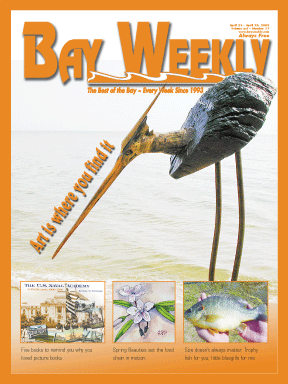
Volume XVII, Issue 17 # April 23 - April 29, 2009 |
 |
 |
| This time of year, I hear a different drummer. My musician plays a quieter tune on sweeter water. My angling passion is for bluegill with the fly rod on our freshwater lakes and ponds. |
Size Doesn’t Always Matter
Trophy rockfish for you; little bluegills for me
With trophy rockfish season open, most Maryland anglers are now devoted to hanging a big one, maybe the fish of a lifetime. Trolling the main stem with parachutes, umbrella rigs and big spoons or fishing the shoreline with bloodworms or cut bait is suddenly the most exciting form of Tidewater angling. But not for me.
This time of year, I hear a different drummer. My musician plays a quieter tune on sweeter water. At this time in the fishing calendar, my angling passion is for bluegill with the fly rod on our freshwater lakes and ponds.
The bluegill, Lepomis macrochirus, is a member of the sunfish family. It is named for the prominent dark blue ear on its gill plate and its bright blue cheek and chin. It is a narrow, deep-bodied fish shaped like a pumpkin seed, which is one of its many monikers.
The male sports a bright orange breast and flanks marked by vertical olive bands, its colors especially iridescent during the spring spawn. It seldom weighs more than a pound in Maryland or any other nearby state, but physical size is the only feature that limits its greatness.
Handsome, aggressive, fierce fighting, prolific and tasty are just a few of the many fine features of this pan fish. Willingness to take a dry fly or a popper is also on that list, probably at the top for me.
Catching ’Em
Mid-April, after a few days of 70-degree weather has warmed the shallows in Maryland’s freshwater impoundments, the best bluegill action starts. The males, or bulls, will seek shallow water two to six feet deep and create a spawning bed or nest by dishing out a circular area in the bottom.
The fish’s activities attract a suitable female, who will deposit her eggs in the nest and depart. The male fertilizes the eggs, then guards the nest, its eggs and the hatchlings against any other fish or aquatic creature that comes near, immediately attacking any interloper.
Flies, poppers or small lures will quickly draw the rowdy fish’s ire. Then the fun starts. Hooked, the bluegill uses its broad side to put maximum stress on the angler’s equipment, circling, diving and refusing to give any quarter. The males are muscular for their size with bulging chests and shoulders. Tested with ultra-light gear, these rascals come off the victor in a scrap as often as not.
If the fish escapes or is released after the battle (as it should be during the spawn), it will return to again guard its nest against all comers. This characteristic ensures the species’ survival and provides discerning anglers with virtually endless future adventure.
Taking a few for dinner, however, will not deplete the stock. The bluegill is so prolific that if their ranks are not occasionally thinned, the lake or pond they occupy will soon become overpopulated with the lusty rascals.
I like to take home fish about nine inches or so in size for my table. An eleven-inch bluegill is a trophy, but it takes about 10 years to attain that size. I prefer to return the larger fish in the hope of future encounters and the smaller ones for a chance to grow up.
Cooking the Feast
Bluegills are best when fried in peanut oil. Dipped in a thick batter of tempura mix and beer and cooked until golden brown, bluegill is a definite treat to the palate. I like them accompanied by a good lager, but a flavorful white wine is not out of place.
Fish Are Biting
Trophy rockfish are in abundance in the mid-Bay. For once, the numbers of big stripers are as good or better here than in the more southern reaches. Most have been taken in the top 10 feet of the water column. Trolling white parachutes and bucktail jigs adorned with nine-inch sassy shad has scored most of the fish, but some anglers are swearing by Big Tonys (spoons) in silver or white. In the early morning or late evening during high water conditions, bait fishermen are doing well with bloodworms and fresh-cut alewife or herring.
© COPYRIGHT 2009 by New Bay Enterprises, Inc. All rights reserved.